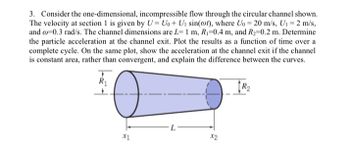
Elements Of Electromagnetics
7th Edition
ISBN: 9780190698614
Author: Sadiku, Matthew N. O.
Publisher: Oxford University Press
expand_more
expand_more
format_list_bulleted
Concept explainers
Question

Transcribed Image Text:3. Consider the one-dimensional, incompressible flow through the circular channel shown.
The velocity at section 1 is given by U=Uo+ U₁ sin(t), where Uo= 20 m/s, U₁ = 2 m/s,
and co-0.3 rad/s. The channel dimensions are L- 1 m, R₁-0.4 m, and R₂-0.2 m. Determine
the particle acceleration at the channel exit. Plot the results as a function of time over a
complete cycle. On the same plot, show the acceleration at the channel exit if the channel
is constant area, rather than convergent, and explain the difference between the curves.
T
R₁
✓
X1
L
X2
Expert Solution
This question has been solved!
Explore an expertly crafted, step-by-step solution for a thorough understanding of key concepts.
This is a popular solution
Trending nowThis is a popular solution!
Step by stepSolved in 3 steps with 5 images

Knowledge Booster
Learn more about
Need a deep-dive on the concept behind this application? Look no further. Learn more about this topic, mechanical-engineering and related others by exploring similar questions and additional content below.Similar questions
- Consider the one-dimensional, incompressible flow through the circular channel shown. The velocity at section 1 is given by U5U0 1U1 sin ?t, where U0 520 m/s, U1 5 2 m/s, and ? 5 0.3 rad/s. The channel dimensions are L51 m, R1 50.2 m, and R2 50.1 m. Determine the particle acceleration at the channel exit. Plot the results as a function of time over a complete cycle. On the same plot, show the acceleration at the channel exit if the channel is constant area, rather than convergent, and explain the difference between the curves.arrow_forwardHow would I calculate the fluid acceleration along the nozzle centerline. Here, there is steady flow of water through an axisymmetric garden hose nozzle and alongthe centerline the water speed increases from uentrance to uexit . The centerline water speed increases parabolically through the nozzle. What would be an equation for centerline speed u(x), based on the parameters given in the drawing from x = 0 to x = L ?arrow_forward5.6 The x component of velocity for a flow field is given as u = Ax²y² where A = 0.3 m3 s and x and y are in meters. Determine the y component of velocity for a steady incompressible flow. Determine the equation of the streamline and plot the streamline that goes thrquek. the noint (x.y)=(1,4).arrow_forward
- Problem 3: Obtaining the stream function from velocity components The steady state, incompressible flow field for two-dimensional flow is given by the following velocity components: V =16y-x and v, =16x + y %3D Determine the equation for the stream function and make sure continuity is satisfied.arrow_forwardt = 0arrow_forward
arrow_back_ios
arrow_forward_ios
Recommended textbooks for you
 Elements Of ElectromagneticsMechanical EngineeringISBN:9780190698614Author:Sadiku, Matthew N. O.Publisher:Oxford University Press
Elements Of ElectromagneticsMechanical EngineeringISBN:9780190698614Author:Sadiku, Matthew N. O.Publisher:Oxford University Press Mechanics of Materials (10th Edition)Mechanical EngineeringISBN:9780134319650Author:Russell C. HibbelerPublisher:PEARSON
Mechanics of Materials (10th Edition)Mechanical EngineeringISBN:9780134319650Author:Russell C. HibbelerPublisher:PEARSON Thermodynamics: An Engineering ApproachMechanical EngineeringISBN:9781259822674Author:Yunus A. Cengel Dr., Michael A. BolesPublisher:McGraw-Hill Education
Thermodynamics: An Engineering ApproachMechanical EngineeringISBN:9781259822674Author:Yunus A. Cengel Dr., Michael A. BolesPublisher:McGraw-Hill Education Control Systems EngineeringMechanical EngineeringISBN:9781118170519Author:Norman S. NisePublisher:WILEY
Control Systems EngineeringMechanical EngineeringISBN:9781118170519Author:Norman S. NisePublisher:WILEY Mechanics of Materials (MindTap Course List)Mechanical EngineeringISBN:9781337093347Author:Barry J. Goodno, James M. GerePublisher:Cengage Learning
Mechanics of Materials (MindTap Course List)Mechanical EngineeringISBN:9781337093347Author:Barry J. Goodno, James M. GerePublisher:Cengage Learning Engineering Mechanics: StaticsMechanical EngineeringISBN:9781118807330Author:James L. Meriam, L. G. Kraige, J. N. BoltonPublisher:WILEY
Engineering Mechanics: StaticsMechanical EngineeringISBN:9781118807330Author:James L. Meriam, L. G. Kraige, J. N. BoltonPublisher:WILEY

Elements Of Electromagnetics
Mechanical Engineering
ISBN:9780190698614
Author:Sadiku, Matthew N. O.
Publisher:Oxford University Press

Mechanics of Materials (10th Edition)
Mechanical Engineering
ISBN:9780134319650
Author:Russell C. Hibbeler
Publisher:PEARSON

Thermodynamics: An Engineering Approach
Mechanical Engineering
ISBN:9781259822674
Author:Yunus A. Cengel Dr., Michael A. Boles
Publisher:McGraw-Hill Education

Control Systems Engineering
Mechanical Engineering
ISBN:9781118170519
Author:Norman S. Nise
Publisher:WILEY

Mechanics of Materials (MindTap Course List)
Mechanical Engineering
ISBN:9781337093347
Author:Barry J. Goodno, James M. Gere
Publisher:Cengage Learning

Engineering Mechanics: Statics
Mechanical Engineering
ISBN:9781118807330
Author:James L. Meriam, L. G. Kraige, J. N. Bolton
Publisher:WILEY